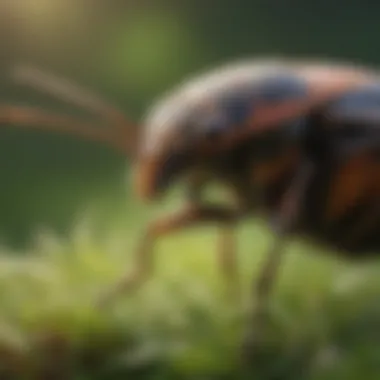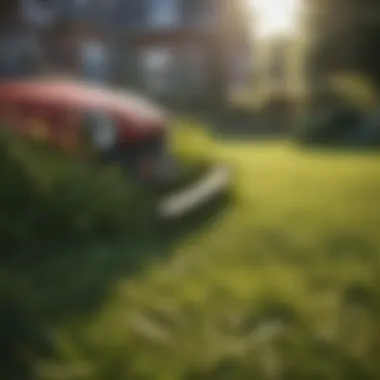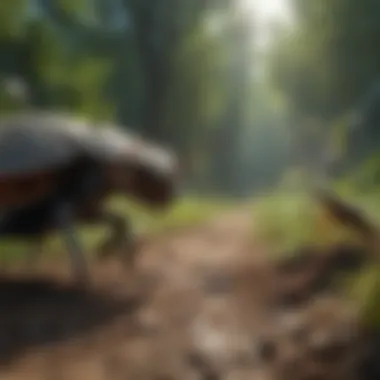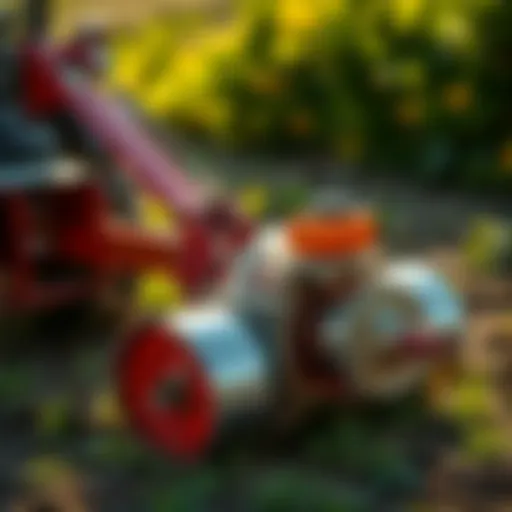Combatting Chinch Bugs: Effective Control Strategies


Intro
Chinch bugs can wreak havoc on lawns and gardens, often leaving behind patches of dead grass that signal their relentless feeding. Recognizing the signs and understanding the life cycle of these pests is paramount. Gardners and farmers alike should be keen to explore effective methods to manage chinch bug populations to prevent extensive damage to your green oasis.
In this article, we will delve into a variety of strategies tailored for both identifying and controlling chinch bugs. By the time you finish reading, you will have a well-rounded look at practical steps and sustainable practices that can restore health to your greenery.
Key Concepts and Terminology
Definition of Terms
Before diving into strategies, it’s helpful to familiarize ourselves with some key terms:
- Chinch Bugs: Small, sap-sucking insects that belong to the Blissus genus, known to affect various types of grasses.
- Nymphs: The immature stage of chinch bugs, which resemble adults but are smaller and lack wings.
- Economic Threshold: The pest density at which control measures should be implemented to avoid economic damage.
Overview of Relevant Practices
Understanding the biological and ecological backgrounds of chinch bugs enhances the effectiveness of control efforts. Key practices include:
- Regular lawn maintenance, such as mowing and watering adequately.
- Monitoring pest populations and identifying signs of an infestation early.
Current Trends and Innovations
Latest Research and Developments
Recent studies highlight the rising concern over chinch bug infestations, largely due to climate changes that may favor their survival and reproduction. For instance, hotter temperatures can accelerate their life cycle, making timely intervention more crucial than ever.
Emerging Technologies and Tools
Innovations in pest management tools have become prominent. For example, the use of pheromone traps has shown to be a promising method for monitoring chinch bug populations. Such traps attract males, providing insight into the timing of natural pest cycles and help determine when control measures should be taken.
Practical Applications
Step-by-Step Guides
- Identification:
- Cultural Control:
- Mechanical Control:
- Chemical Control:
- Examine your lawn for signs of chinch bugs. Look for yellowing patches, especially during dry spells. During a sunny day, part the grass blades to spot the tiny dark bugs moving around.
- Maintain optimal lawn health through proper watering, fertilization, and mowing. Thicker grass can often outcompete chinch bugs.
- Introduce physical barriers, such as barriers made of mulch or netting, to keep chinch bugs from entering your garden.
- If an infestation occurs, consider targeted insecticides designed specifically for chinch bugs. Always follow the instructions to minimize any unintended impact on beneficial insects.
Troubleshooting Common Issues
Some common problems include:
- Misidentification of Damage: Always ensure that the damage is indeed caused by chinch bugs and not from other factors like drought stress or disease.
- Over-reliance on Chemicals: While chemical control can be effective, overuse leads to resistance, making future management much harder. Adopting an integrated pest management approach can alleviate this issue.
"Preventive measures can save your lawn from damage. Regular checks and maintenance are key to chinch bug management."
By putting together this skilled mix of cultural, mechanical, and chemical practices tailored for chinch bugs, you'll be better prepared to protect your landscapes. The journey to a lush, healthy yard starts with understanding these pests and being proactive in your approach.
Understanding Chinch Bugs
Chinch bugs are often overlooked pests, but understanding their biology and behavior is critical for effective management. They don't just wreak havoc on lawns; they also represent a challenge for agricultural practices. Without comprehending how these insects operate, one might miss the signs of their presence until it's too late. A deep dive into their life cycle, species variation, and indicators of infestation lays the groundwork for informed choices in pest control strategies. This is where success begins – by identifying the problem properly.
Biology and Life Cycle
An appreciation of the biology and life cycle of chinch bugs is paramount. These insects typically undergo simple metamorphosis. Starting as eggs, they hatch into nymphs – tiny and red with a touch of black – before evolving into adult bugs. This entire process, from egg to adult, occurs over a span of a few weeks, typically aligning with warmer months when grass is lush and thriving. Understanding this cycle helps in making timely decisions regarding interventions, be it preventive or reactive.
Understanding chinch bug reproduction patterns can also highlight their potential for rapid population growth. A single female can lay up to several hundred eggs in her lifetime. They often prefer stress conditions in grass to flourish. This makes lawns suffering from drought or poor health particularly susceptible. Meanwhile, knowing their preferred host plants adds another layer of strategy to pest management.


Identifying Chinch Bug Species
The landscape is dotted with diverse varieties of chinch bugs, including the Southern Chinch Bug and the Blissus leucopterus. Identifying which species is infiltrating your garden is critical, as different species exhibit varying resistance to control methods. The Southern Chinch Bug, for example, is particularly problematic in the southeastern United States, thriving in hybrid Bermuda grasses, while others may be more adaptable.
A visually adept gardener can discern chinch bugs during their nymph stage by their size – around 1/16th of an inch – and distinctive coloration. Adult chinch bugs are larger, roughly a quarter of an inch, and feature their hallmark black and white markings. Keeping tabs on their form and characteristics is essential when aiming for an accurate identification of the intruders. This step enables effective communication with pest control experts and lays the foundation for specifying appropriate control measures.
Signs of Infestation
Recognizing signs of chinch bug infestations can make or break the effort to manage them. Early detection can save your garden from severe damage. Common signs to look for include:
- Yellowing patches of grass: Dead patches that keep expanding can signal a budding infestation.
- Stunted growth: Grass that fails to thrive is often a red flag.
- Presence of the bugs themselves: Upon closer inspection, finding them in clusters in grass stems confirms their presence.
- Flecking on the grass blades: As they puncture the blades to draw sap, tiny spots can appear, which may be mistaken for disease.
"Following the trail of wilting grass can guide you toward where chinch bugs are most concentrated."
The Environmental Impact on Chinch Bug Populations
Understanding the environmental factors that affect chinch bug populations is critical for both preventative measures and control strategies. The health of a lawn or garden is intricately tied to various ecological elements, as chinch bugs are influenced by not only climate but also soil types and the plants that fill the landscape. By grasping how these environmental aspects work together, farmers and gardening enthusiasts can create less favorable conditions for chinch bugs, thereby minimizing their impact.
Climate Factors
Climate plays an essential role in chinch bug life cycles. Temperature and humidity significantly affect their population dynamics. Generally, these insects thrive in warm, dry conditions. Ideal temperatures for chinch bug activity range from 80 to 90 degrees Fahrenheit. If you live in a region that experiences prolonged periods of heat and low moisture, you’re likely looking at an increased risk for infestations.
It’s not just about the warmth, though. Changes in rainfall patterns can create pockets of drought-like conditions, which also favor chinch bug multiplication. On the flip side, excessive rainfall can reduce populations by washing them away or creating environments where beneficial nematodes flourish, serving as natural predators.
"Understanding the right climate can lead to better preventative measures, potentially keeping chinch bugs in check and preserving the health of lawns and gardens."
Soil Conditions
Soil conditions are equally important when examining the factors influencing chinch bugs. They prefer light, sandy soils that offer good drainage and allow them to burrow effectively. Soil that retains moisture can create a habitat in which beneficial microorganisms can thrive, providing a healthier ecosystem. Meanwhile, compacted soils can inhibit the natural predators of chinch bugs.
Consider practices like soil aeration or the introduction of organic matter to enhance soil health. Healthier soil not only promotes robust plant life, making it less appealing to chinch bugs but also supports beneficial creatures, such as beetles and spiders, that help control pest populations.
Plant Composition
The types of plants grown in a given area play a significant part in chinch bug management. For instance, certain warm-season grasses are more attractive to chinch bugs than others. Zoysiagrass and Bermuda grass are often favored by these pests, while fescue and ryegrass tend to be less susceptible. By carefully selecting grass types and other landscaping plants, you can create a more resilient environment.
Additionally, diversity in plant composition can deter chinch bugs. Monoculture plantings can create an ideal breeding ground, providing everything these pests need to thrive. Instead, a mix of plants can disrupt their life cycle.
Regular monitoring of plant health can also help, since stressed plants are more vulnerable to chinch bug damage. A proactive approach to plant diversity and health ultimately contributes significantly to avoidance of chinch bug infestations.
Cultural Control Methods
Cultural control methods form the backbone of sustainable pest management, especially when dealing with chinch bugs. These strategies are about manipulating the environment to create conditions unfavorable for pest survival. In particular, they focus on establishing a proactive approach that minimizes the chances of infestation in the first place. Rather than solely relying on chemical interventions, cultural controls advocate for practices that maintain a healthy ecosystem, which in turn supports plant vigor and resilience.
Maintaining Healthy Lawns
A robust lawn is less inviting to chinch bugs, and one of the most effective preventive measures is adopting practices that promote healthy grass growth. This includes regularly aerating the soil to ensure water and nutrients reach the root zone effectively. Compacted soil is a breeding ground for pests, so addressing this issue can significantly improve lawn health.
You might also want to consider installing a proper mowing schedule. Keeping the grass at the recommended height not only discourages pest activity but also fosters a thicker turf that naturally competes with unwanted insects. When grass is cut too short, it becomes weak and stress-prone, making it more susceptible to infestation.
Proper Watering Techniques
Watering practices are crucial in thwarting chinch bugs. Overwatering creates saturated conditions that can lead to mold, which chinch bugs find appealing for hiding. Instead, aim for deep and infrequent watering. This strategy encourages deeper root growth and helps the grass tolerate any potential stress.
Consider using a soaker hose or drip irrigation to provide water directly to the root zone. By minimizing surface watering, you reduce the chances of creating a moist environment that attracts pests.
Regularly monitoring your lawn for signs of dehydration is also helpful. If the lawn starts to show signs of drought stress, then it's time to water. But remember, not every drought result in chinch bug problems; sometimes the lawn just needs a little TLC.
Adjusting Fertilization Practices
While fertilizers are crucial for maintaining plant health, improper usage can lead to increased vulnerability to chinch bugs. In general, focus on applying fertilizers that promote slow and steady growth rather than causing a rapid surge of growth. This approach ensures that the grass can better withstand pest pressures without becoming too lush and therefore more appealing to chinch bugs.
It's also important to test your soil to understand its current nutrient levels. This allows for more precise adjustments that suit your lawn's specific needs. Balancing the nutrient profile can lead to healthier grass, thereby reducing the chances of infestations.
"Healthy soil leads to healthy plants; healthy plants resist pests better than weak ones."


Altogether, these cultural control methods not only cater to the immediate needs of your lawn but also contribute to long-term sustainability and health. By creating an environment that naturally discourages chinch bug populations, landowners can enjoy a thriving, vibrant green space with reduced pest concerns.
Mechanical Control Strategies
Mechanical control strategies play a crucial role in the multifaceted approach to managing chinch bug infestations. While chemical herbicides can be effective, relying solely on them may not always be sustainable or safe for the environment. Instead, mechanical methods provide a proactive approach, reducing reliance on chemicals and lessening the environmental footprint. They help to disrupt the life cycle of chinch bugs directly and can be implemented easily by farmers and garden enthusiasts alike.
Regular Mowing Techniques
Regular mowing proves beneficial in managing chinch bug populations. Keeping your grass at the right height not only promotes health but also deters these pests. Chinch bugs prefer longer grasses where they can hide, so keeping the grass trimmed short can reduce their habitat.
- Mowing Height: Aim to maintain grasses at a height around 2.5 inches to 3 inches. Taller blades create an appealing environment for chinch bugs.
- Mowing Frequency: Regularly mow once every week during peak growing season. This does not only keep chinch bugs at bay but also encourages grass density, which naturally inhibits pest invasions.
- Disposal Practices: After mowing, avoid leaving clippings on the lawn because they can provide shelter for chinch bugs. Appropriate removal helps in minimizing their presence.
Physical Barriers and Traps
Creating physical barriers and traps is another effective way to manage chinch bugs. These methods serve as both prevention and control tools.
- Row Covers: Lightweight fabric can be draped over new grasses or seedlings. This shield prevents adult chinch bugs from reaching vulnerable plants. It’s a simple and economical barrier.
- Homemade Traps: Setting traps can be effective. One can use shallow containers filled with soapy water placed around infested areas to attract and trap chinch bugs. Add a bit of detergent to the water to break the surface tension, ensuring the bugs can’t escape.
"Using homemade traps not only captures pests but can also be a great educational project for those new to gardening."
Encouraging Natural Predators
Natural predators are an asset in the war against chinch bugs. By fostering a conducive environment for beneficial insects, you can effectively reduce pest populations.
- Ladybugs and Lacewings: These insects feaste on chinch bugs. Planting flowers such as dill or fennel can attract these predators.
- Birdhouses: Installing birdhouses encourages beneficial birds like blue jays and sparrows that dine on chinch bugs.
- Avoiding Pesticides: Refraining from chemical pesticides ensures that natural populations of predators are not harmed, contributing to a balanced ecosystem and more effective pest management.
Implementing these mechanical strategies relies less on chemical methods, promotes ecosystem health, and can firmly place the power back in the hands of the gardener or farmer. By combining these tactics effectively, one can create a sustainable landscape resistant to chinch bug infestations.
Chemical Control Options
When considering how to tackle chinch bug infestations, chemical control options are often viewed as a substantial part of the overall strategy. While cultural and mechanical methods hold their own merits, the application of chemicals can deliver swift and decisive results, especially in the face of severe outbreaks. Understanding insecticides and how to implement them properly can make a world of difference for both preventative measures and treatment scenarios.
Insecticides: Types and Applications
Insecticides vary widely in terms of their formulation and use. Here’s an overview of some common types effective against chinch bugs:
- Pyrethroids: These synthetic insecticides mimic the natural insecticidal properties of chrysanthemum flowers. They work by affecting the nervous system of the bugs. Examples include permethrin and bifenthrin, which are often used in residential lawns.
- Neonicotinoids: This group, such as imidacloprid, targets the insect's nervous system and is usually applied as a systemic treatment. When applied to the soil, these chemicals are absorbed by plants and break the chinch bugs' feeding cycle.
- Insecticidal Soaps and Oils: Though generally less harmful to the environment, their effectiveness can vary. They suffocate the chinch bugs upon contact. It might take multiple applications to achieve desired results.
When applying these insecticides, timing and method are critical. Always follow the instructions on the label for application rates and timing in order to achieve maximum efficacy without risking harm to beneficial organisms or the environment.
Timing Treatments for Efficacy
The timing of insecticide applications can greatly influence their effectiveness against chinch bugs. Ideally, treatments should be applied early in the season when the bugs are first spotted—in other words, before their populations explode. Staying vigilant and monitoring your lawn during late spring through early summer is crucial.
Key points to consider include:
- Initial Infestation Signs: Recognizing the tell-tale signs, such as wilting grass blades or patches of dead turf, is essential. Applying treatment at this stage can significantly mitigate damage.
- Weather Conditions: Avoiding treatment in extreme heat or direct sunlight is wise, since these conditions can reduce the effectiveness of many insecticides. Early morning or late afternoon are often ideal.
- Follow-up Applications: Depending on the product and severity of the infestation, follow-up applications may be necessary. Keeping an eye on the treated areas can help determine if the chemical is working or if further action is needed.
Safety Considerations
While chemical controls can help combat chinch bug infestations effectively, it's essential to keep safety at the forefront of any agricultural practice. Consider the following:
- Protective Gear: Always use gloves, masks, and protective eyewear during application. This not only protects you but also reduces the risk of inadvertent exposure to family members and pets.
- Environmental Impact: Chemicals may affect non-target organisms. Think about incorporating barriers or timing your applications for when beneficial insects are less active, for instance, applying early morning before beneficial pollinators start to work.
- Following Instructions: Adhering strictly to the information provided on product labels is non-negotiable. Misapplication or overuse can lead to crop damage or increased resistance among chinch bugs.
In summary, while chemical control options are undeniably potent, combining them with other tactics leads to the most sustainable and effective pest management strategy. Always strive for a responsible approach in managing both your lawn's health and the local ecosystem.
Integrated Pest Management Approaches
Integrated Pest Management (IPM) is a holistic approach essential for tackling chinch bug infestations effectively. Rather than relying solely on chemical solutions, which can pose various risks, IPM combines different management strategies, including cultural, mechanical, and biological controls. Such an approach benefits not only the immediate needs of pest control but also enhances long-term ecological balance in gardens and lawns.
One of the primary advantages of IPM is its sustainability. By diversifying methods, it reduces the dependency on harsh chemicals which can harm non-target species and degrade soil health. Plus, it empowers individuals to take proactive measures, enhancing their understanding of the ecosystem in their backyards.
Incorporating various strategies helps build resilience against future chinch bug outbreaks, ensuring that pest management is not just a reactive measure but rather part of a broader ecological practice. The beauty of IPM lies in its versatility and adaptability to the specific conditions of your environment.


Combining Control Methods
When addressing chinch bug infestations, combining control methods under IPM is like creating a Swiss Army knife of strategies. Each method has its strengths, and when utilized together, they can deliver more effective results. For instance, cultural practices such as maintaining healthy lawns can work alongside mechanical methods like regular mowing.
Practical Examples of Combination Strategies:
- Healthy Lawn Maintenance + Natural Predators: Encouraging beneficial insects such as ladybugs can significantly reduce chinch bug populations while maintaining strong grass health.
- Regular Mowing + Trapping: Keeping grass at optimal heights can deter chinch bug nesting, while traps can physically capture pests.
- Irrigation Adjustments + Insecticides: Using proper watering techniques can reduce stress on plants, making them more resilient against chinch bugs while insecticides can be employed as a last resort.
The synergy between these methods breeds a more robust response to pest pressures. You’re not just putting a Band-Aid on a problem but addressing it from multiple angles, which promotes a healthier ecosystem overall.
Monitoring and Assessment Techniques
Monitoring and assessment are pivotal to the IPM framework, allowing the gardener or farmer to gauge the effectiveness of their strategies. The key is to be vigilant and proactive. Regular inspections can help in determining the presence of chinch bugs early before they escalate into full-blown infestations.
Monitoring Tips:
- Visual Check-Ups: Look for signs of chinch bugs in the morning when they are most active.
- Turf Inspection: Inspect areas where grass is turning brown or shows signs of damage.
Assessment Techniques:
- Soil Sampling: Evaluating soil conditions can reveal potential threats, revealing both chinch bug presence and overall soil health.
- Assessing Damage Patterns: Understanding where the damage is most prevalent can guide more targeted response strategies.
These monitoring tactics not only save time and resources but also enable the gardener to adapt their methods based on real-time data, turning pest management into a responsive and informed process.
"Effective pest management is not about eradication but understanding the balance of nature."
In incorporating IPM approaches, we foster a culture of informed gardening practices. This creates a safer environment for our gardens and contributes to a larger ecosystem that thrives, making it so much easier to maintain those green spaces without falling into the pitfalls of purely chemical-based solutions.
Preventive Measures Against Future Infestations
Taking a proactive stance against chinch bug infestations is crucial for maintaining the health and wellness of gardens and lawns. Preventive measures not only address existing issues but also diminish the likelihood of future outbreaks. The benefits of these measures include reducing reliance on more aggressive control strategies like pesticides and promoting overall ecological balance. Additionally, thoughtfully executed preventive practices can conserve resources and improve plant vitality, which is especially pertinent in today's environmentally conscious landscape.
Choosing Resistant Grass Varieties
One of the most effective preventive strategies is selecting grass varieties that are naturally resistant to chinch bugs. Not all grasses react the same way to these pests. Some types, such as Zoysia and Bermuda grass, tend to be less attractive to these insects, making them ideal choices for new lawns or renovations.
When opting for resistant varieties, consider the following factors:
- Local Climate: Different grass types thrive in diverse climates, and choosing a variety that suits your local weather will lead to better growth and natural resilience.
- Soil Type: Understanding your soil’s composition helps in making informed decisions, as some grasses perform better in sandy soils, whereas others prefer clay.
- Water Requirements: Opt for grass varieties that align with your irrigation capabilities; drought-tolerant species can reduce the need for excessive watering, which in turn can help keep chinch bugs at bay.
Planting these resistant types can create a more robust lawn that stands a better chance against chinch bug attacks, allowing you to spend less time managing pests and more time enjoying your green space.
Seasonal Maintenance Routines
Regular seasonal maintenance routines are another facet of effective chinch bug prevention. Keeping your lawn in pristine condition can significantly lower the risk of infestation. Here’s how to implement a practical schedule:
- Early Spring Assessment: As the weather warms up, give your lawn a good look over. Reseed bare patches and make sure your grass is healthy enough to withstand pests.
- Mowing: Regular mowing not only keeps your lawn looking sharp but also helps control chinch bug populations. Mow at a height between two and four inches, ensuring that grass is strong enough to resist infestations.
- Focused Watering: Keep consistent watering practices. Chinch bugs thrive in dry soil, so maintaining adequate moisture can help deter them. However, be cautious of overwatering, which can lead to other issues.
- Fall Preparation: As the season turns, aerate your lawn. This provides the roots with access to air, water, and nutrients, strengthening the plants and increasing their resilience against pests.
Implementing these seasonal routines not only helps stem potential chinch bug invasions but also nurtures a healthy ecosystem within your lawn.
"Prevention is better than cure." Taking steps today can save you headaches tomorrow, keeping your garden thriving and lush.
End and Final Thoughts
In wrapping up this exploration of chinch bug management, it’s vital to reflect on the broad scope of strategies highlighted throughout the article. The dance between controlling these pests and sustaining a healthy garden ecosystem cannot be overstated. Chinch bugs may seem like a minor annoyance, yet they wield the potential to transform vibrant green lawns into patches of despair if left unchecked.
Recap of Effective Strategies
To tackle chinch bugs effectively, it all starts with understanding their biology and life cycle. Knowing when and where to look can save countless hours in a season when these critters might be most active. From cultural practices such as maintaining healthy lawns to mechanical methods like regular mowing, each tactic plays its role in an integrated pest management approach. Here’s a quick recap of the key strategies discussed:
- Cultural Controls: Regular maintenance and proper lawn care go a long way in keeping chinch bugs at bay. This includes timely watering and appropriate fertilization.
- Mechanical Controls: Utilizing practices like physical barriers, and encouraging natural predators are simple yet effective. You draw on nature’s resources rather than relying solely on chemicals.
- Chemical Controls: Select insecticides should be applied judiciously, keeping in mind the timing and potential impact on surrounding flora.
It's about combining these methods effectively. Rather than reaching for a single solution and crossing fingers, recognize that a collaborative approach yields the best results.
Encouragement for Sustainable Practices
The need for sustainable practices in agriculture and gardening becomes clearer when discussing pest control. By focusing on eco-friendly strategies, not only do we safeguard our lawns, but we also protect the broader environment. Sustainable practices could include:
- Choosing resistant plant varieties: Selecting grass types that chinch bugs avoid can save you a considerable headache down the line.
- Seasonal maintenance routines: Regular lawn care in tune with the seasons fosters resilience against pest infestations.
- Educating oneself and others: Sharing insights and discoveries helps reinforce a community's collective knowledge regarding pest management.
"Sustainability isn’t just a buzzword; it's a necessary approach for long-term success in gardening and agriculture."







